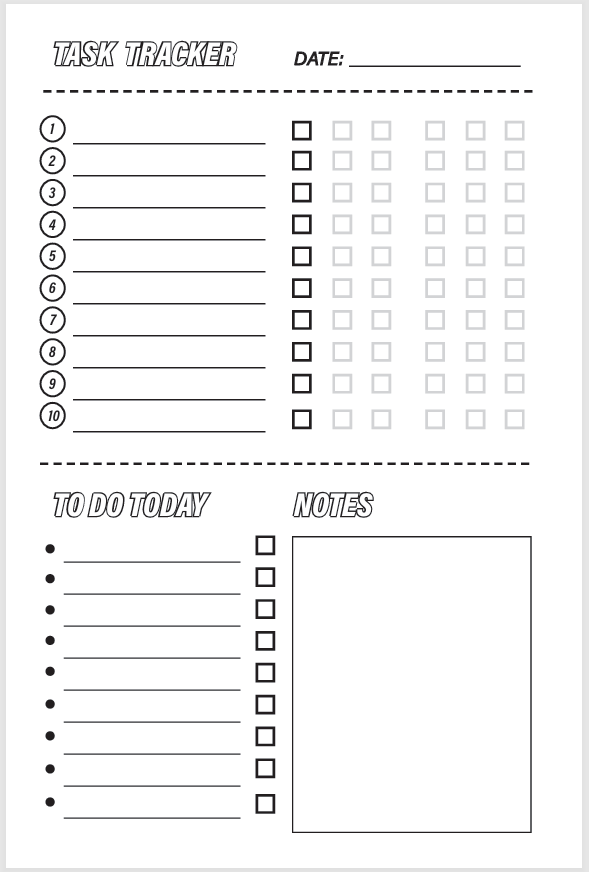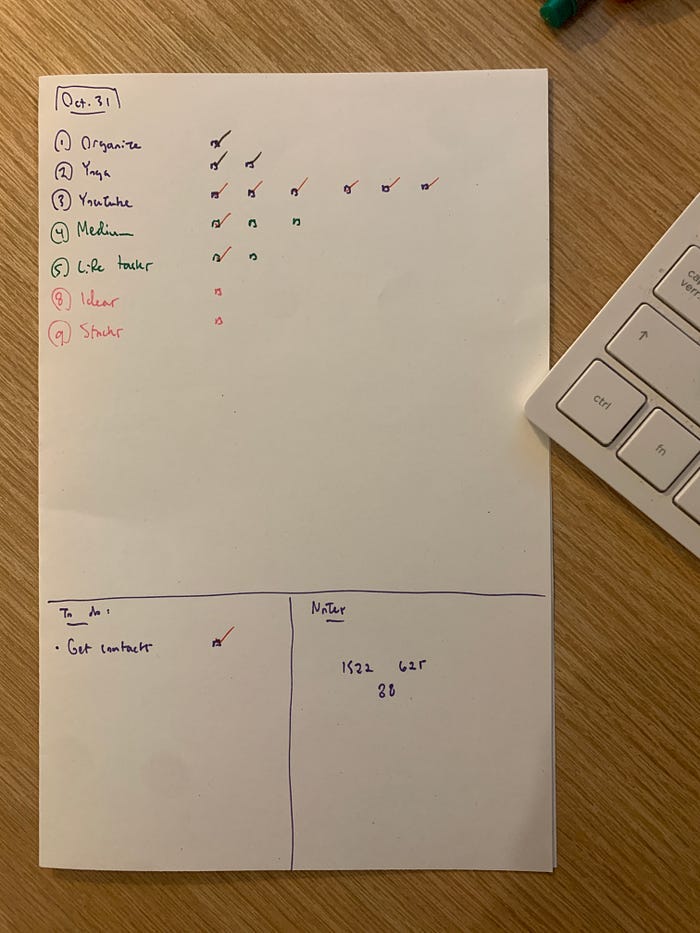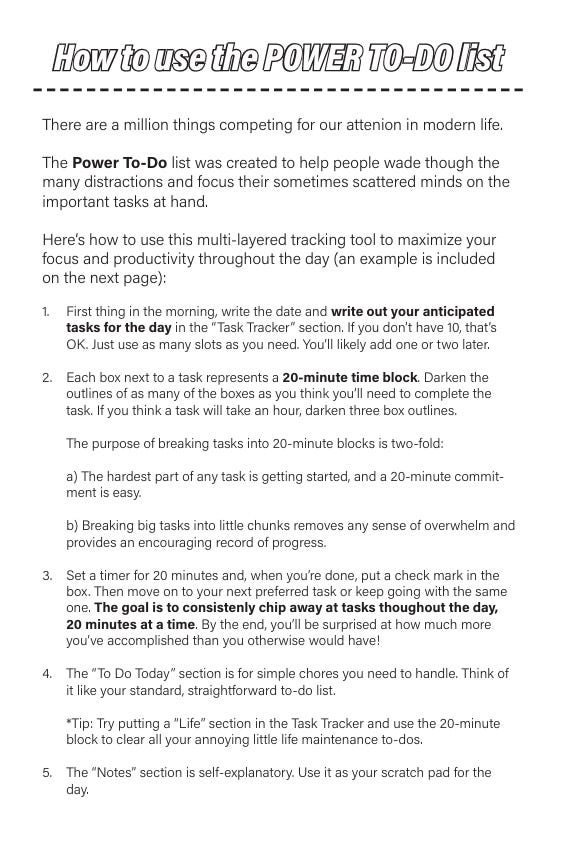How I finally beat procrastination with 1 simple sheet of paper
Living with my ADHD brain is like being the rope in a tug-of-war.
Pulling from one end: the urge to do everything.
Pulling from the other end: the urge to do nothing.
Do you suffer from the same thing?
Because my brain tends to go off in a million different directions, it’s sometimes hard to remember where I started and what I was supposed to be doing in the first place.
Eventually, it becomes so overwhelmed by all the options that it simply goes catatonic.
The end result?
I wind up doing something stupid or useless until the burden of my ever-growing to-do list becomes too heavy to bear.
My solution in the past was to calm my brain with alcohol, which turned me into a physical and mental dumpster fire.
But eventually I came to the realization that in order to accomplish anything notable in the second half of my life, I will always have to lean heavily on systems.
Think of it like spotting arrow markers on a nature hike.
You’re wandering around and there are lots of interesting things to see, but you’d better stay on the path if you don’t want to get lost.
I continue to use various systems to keep my brain on track, but I’ve found lately that one is more effective than all the rest.
And all you need to get started is 1 simple, white sheet of paper.

Productivity paper — the free, simple version
Everyone struggles with sometimes lengthy, demoralizing phases when the urge to procrastinate overwhelms their otherwise good intentions.
For me, those phases have become so rare they’re barely worth a mention.
How did I manage this?
I’m going to explain it to you, but I’m warning you: your first reaction is probably going to be, “What’s the big deal James? This is so simple.”
I would strongly urge you not to dismiss it because it seems too good to be true.
While it does draw on simple systems like…
… for some reason, the combination of all three in this 1 particular way pumped my productivity to levels I hadn’t seen before.
Here’s what I did until very recently.
First thing in the morning (IMPORTANT), I take 1 white sheet of paper, fold it in half, and write the date at the top.
I split what is now a half page into 3 sections:
1 for managing and timing tasks
1 to-do list for life chores I need to take care of
1 little notes section for scratching things out like phone numbers, doing calculations, etc.
Here’s what a recent one of mine looked like:
Each box you see to the right of a task represents a 20-minute block of time.
I estimate how much time I want to dedicate to a task that day and draw as many blocks as I need.
Then, all I do all day is chip away at these blocks 20 minutes at a time.
Typically I’ll work on one task for 20, then move on to the next one for 20, and so forth — this helps keep my ADHD brain occupied with a bit of novelty.
Now before you dismiss this or go off and try it yourself, please let me explain why the time component is so, so important.
It really is the key to everything.
Why this works better than any other productivity system I’ve tried
I’ve done some thinking about why this productivity system has worked better for me than any other, and I think it comes down to 3 things:
By setting your focus and intention first thing in the morning and blocking out some time, you tame your day before it can get away from you … if you’re like me, you will come to love the feeling of control (lol).
Side note 1: Yes there are times when you’ll have to adjust on the fly, but I’ve found that, for the most part, things unfold the way you expect them to.
Side note 2: There are some days — maybe many days — where you don’t put a checkmark in every box. HOWEVER, you’ll have definitely accomplished more than you would have with no plan at all.
2. Because of the way my brain works, journalism was probably the right career choice for me based on one important factor: TIGHT DEADLINES EVERY DAY. Blocking out your expected blocks and setting a timer puts you on a deadline and motivates you to complete the task on time.
3. Chunking big tasks down into small time blocks makes “overwhelming” projects seem tangible and manageable. Psychologically, it also helps you get past the toughest part of any project — getting started.
Anyone can manage 20 minutes of anything, right?
In the next section, I’ll give you an example of a project I’m very proud of that never would have seen the light of day if I hadn’t used this system.
Productivity paper — pumped up
Anyone can copy this for free, but in order to save myself some time and maybe help out my readers too, I actually designed this page and put it into a simple productivity tool that I call the POWER TO-DO list.
You can buy it for cheap on Amazon using this link.
This is the first physical product I’ve made that I’m actually super proud of because I honestly believe it has the power to help a lot of people like me.
What I did was take my one-sheet strategy and put it into a small notebook that you can tote around with you. There are enough pages for about 3 months’ worth of productive days (I wanted to keep it thin enough to still be easy to write in and carry around).

Here’s my explanation of how to use it, which you can also use to guide your own experiments:
The fact that this book even exists is a testament to how well my system works.
I’ve tried publishing a few things on Kindle Direct Publishing before, and they were all duds.
I think part of the reason is that I wasn’t passionate about those projects.
I was passionate about creating the POWER TO-DO List, but the project seemed overwhelming at first:
I didn’t have a page design
I didn’t have a logo
I didn’t have the graphic assets
I’d forgotten the dimensions for a KDP book and how to format it
And a bunch of other hurdles
In the past, I would have 100% quit before it saw the light of day … too much work, don’t know where to start.
This time, I just chipped away 20 minutes at a time.
It’s just 20 minutes!
And then, lo and behold, eventually those 20-minute blocks added up over a week or so to 4–5 hours, and I had a finished product for sale!
I DARE you to try this
Convincing people to just try my system is like pulling teeth.
I bought copies of the Power To-Do List for my wife and kids, and while they all pledged to give it a try, they have yet to get started.
The urge to procrastinate is all-powerful … so much so that people even procrastinate when starting an anti-procrastination system.
That’s why I am now daring you to give it a try for 30 days.
I really believe that, at the very least, you’ll see some notable productivity gains.
And the best-case scenario is that it completely transforms your life the way it has for me.
What do you have to lose?
Do you struggle with procrastination?
What systems do you use to beat procrastination?
Let me know in the comments!
My top 5 trending stories right now





